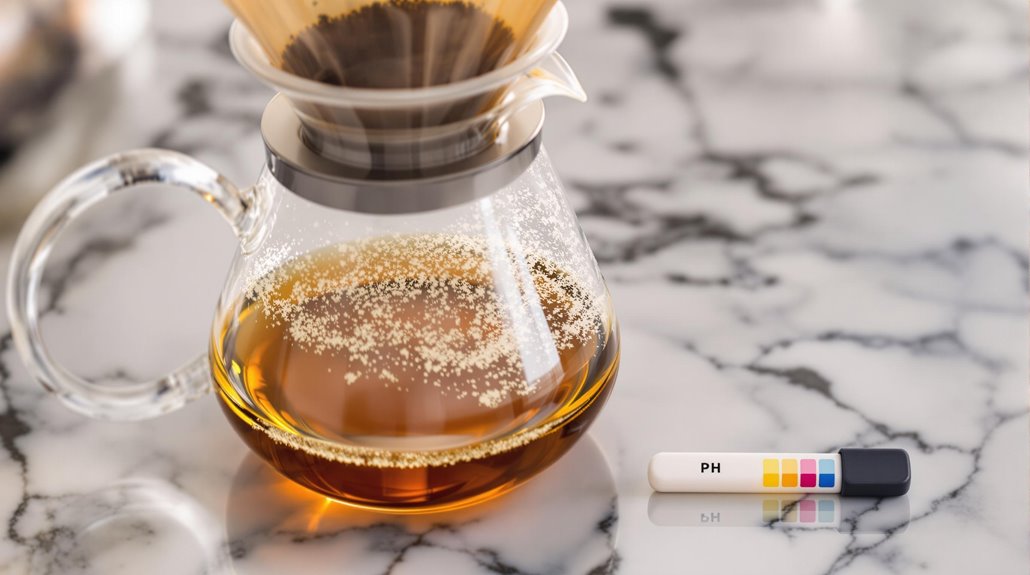







Ever wondered why your morning cup of coffee sometimes leaves a tangy aftertaste? You might be surprised to learn that coffee's acidity isn't just about flavor—it's a complex interplay of factors like bean origin, roast level, and brewing method. While it's less acidic than orange juice, it's still enough to make you question how it affects your body. Does a darker roast mean less acidity? Can your brewing method change the game? The answers might just reshape how you enjoy your daily brew—but there's more to uncover before you take your next sip.
Key Takeaways
- Coffee is slightly acidic, with a pH range of 4.85 to 5.10, making it less acidic than many other beverages like orange juice.
- Acidity in coffee refers to bright, tangy flavors, influenced by bean origin, roast level, and brewing method, not sourness.
- Light roast coffee is more acidic than dark roast due to higher retention of natural acids like chlorogenic acid.
- Cold brew coffee is less acidic (pH ~6.0) compared to hot-brewed coffee, making it a gentler option for sensitive stomachs.
- High-altitude beans, such as those from Ethiopia, often have higher acidity, while Brazilian and Sumatran beans are naturally lower in acidity.
What Is Acidity in Coffee?
Acidity in coffee refers to the bright, tangy, or sharp flavors that define its taste profile, influenced by factors like bean origin, roast level, and brewing method. When you taste coffee, the acidity isn't the same as sourness; instead, it's a complex interplay of acids that create fruity or citrus-like notes, such as lemon or berry flavors. These acids, including chlorogenic acid, contribute to the overall sensory experience. Coffee's pH typically ranges from 4.85 to 5.10, making it slightly acidic compared to neutral water. High-altitude beans often exhibit higher acidity due to slower maturation, which allows more time for acids to develop. Light and medium roasts retain more of these natural acids, while darker roasts lose some acidity as prolonged roasting breaks down chlorogenic acid and other compounds. Brewing methods also impact acidity; for example, cold brew tends to have lower perceived acidity due to its extraction process. Understanding acidity helps you appreciate the nuanced flavors in your cup, whether it's a bright Ethiopian light roast or a mellow dark roast.
The Ph Level of Coffee

Coffee typically has a pH level ranging from 4.85 to 5.10, placing it on the acidic side of the pH scale, which measures acidity (below 7.0) and alkalinity (above 7.0). A pH of 5.0 is often considered balanced, contributing to coffee's characteristic mix of sweetness and acidity. Factors like bean origin, roast level, and brewing method can influence this pH range, while additives like milk or alkaline water may slightly raise the pH, reducing its acidity.
Coffee Ph Range
The pH level of coffee plays a significant role in shaping its flavor profile and overall sensory experience. Coffee typically falls within a pH range of 4.85 to 5.10, placing it on the slightly acidic side of the pH scale. This average pH level contributes to the bright, tangy notes often associated with coffee acidity. The pH scale, which ranges from 0 (highly acidic) to 14 (highly alkaline), helps quantify this acidity, with 7 being neutral. A pH of 5.0 is often considered balanced, offering a harmonious blend of sweetness and acidity. Factors like bean origin, roast level, and brewing method influence coffee's pH levels. For instance, dark roast coffee tends to have a slightly lower pH (less acidic) compared to light roast coffee, which retains more of its natural acidity. Understanding the pH levels of coffee helps you appreciate how subtle variations can impact its taste and mouthfeel, making it a key factor in both brewing and enjoyment.
Acidity vs. Alkalinity
When considering the pH level of coffee, it's important to understand how acidity and alkalinity interact within the beverage. The pH of a substance measures its position on a scale from 0 (highly acidic) to 14 (highly alkaline), with 7 being neutral. Coffee typically has a pH between 4.85 and 5.10, placing it on the acidic side. This acidity of coffee stems from organic acids like chlorogenic acids, which contribute to its bright, tangy flavor. Chlorogenic acids break down during roasting, which is why dark roast coffee often has a slightly lower acidity (higher pH) compared to light roasts. Cold brew coffee, brewed with cold water, also tends to have a higher pH, as it extracts fewer acidic compounds. If you prefer a less acidic cup, adding milk or almond milk can slightly neutralize the acids in coffee, raising its pH closer to neutral. Understanding these factors helps you tailor your coffee experience, whether you seek higher acidity for a vibrant taste or a smoother, less acidic profile.
Factors Influencing Coffee Acidity

The origin of coffee beans greatly impacts their acidity, with high-altitude regions like Ethiopia and Kenya producing beans that develop higher levels of chlorogenic acids due to slower growth. Roast level also plays a critical role, as lighter roasts retain more natural acids, while darker roasts break down these compounds, reducing overall acidity. Understanding these factors helps you predict and control the acidity profile of your coffee.
Bean Origin Impact
Exploring the impact of bean origin on coffee acidity reveals how environmental and agricultural factors shape flavor profiles. The altitude at which coffee beans grow substantially influences their acid content. High-altitude coffees, like those from Ethiopia or Kenya, develop higher acidity due to slower bean maturation and increased chlorogenic acid production. In contrast, beans from lower-altitude regions, such as Brazil or Sumatra, often exhibit lower acidity because of faster growth and specific processing techniques like wet-hulling. Soil composition also plays a critical role; volcanic soils in Central America, rich in minerals, enhance the uptake of nutrients that contribute to the natural acids in green beans. Arabica beans, typically grown at higher elevations, are more acidic than Robusta beans, which thrive in lower-altitude environments. Processing methods further modulate acidity; washed processing, common in African coffees, preserves more natural acids, while methods like wet-hulling reduce acidity. By understanding these factors, you can better predict the acidity of coffees based on their origin.
Roast Level Influence
Considering the impact of roast level on coffee acidity, light roasts retain higher levels of chlorogenic acids, which contribute to a brighter, more acidic flavor profile. These compounds break down as roasted coffee beans are exposed to higher temperatures and longer roasting times. Dark roast coffee, roasted at temperatures above 400°F (204°C), undergoes significant degradation of chlorogenic acids, resulting in a smoother, less acidic cup. Medium roasts strike a balance, offering a moderate pH level of around 5.0, making them less acidic than light roasts but brighter than dark roasts. The longer the roasting process, the more acidic compounds degrade, reducing the overall acidity. Light roast coffee, with its shorter roasting time, preserves these acids, delivering a tangy, vibrant taste. If you prefer a less acidic coffee, opting for a dark roast will provide a mellower flavor due to the reduced presence of chlorogenic acids. Roast level directly influences the chemical composition of coffee, making it a critical factor in determining acidity.
Health Effects of Coffee Acidity

Coffee's acidity, with a pH ranging from 4.85 to 5.10, can impact your digestive health, particularly if you have conditions like acid reflux, gastric ulcers, or irritable bowel syndrome (IBS). The chlorogenic acid in coffee, while beneficial for its antioxidant properties, can stimulate stomach acid production, potentially worsening symptoms of acid reflux or heartburn. If you're sensitive to acidity, you might experience stomach discomfort after drinking highly acidic coffee. To reduce the acidity, consider switching to low acidity options like cold brew, which contains up to 70% less acidity than hot-brewed coffee. Adding milk or plant-based alternatives can also neutralize coffees acidity, making it gentler on your stomach. While coffee doesn't directly cause acid-related conditions, its acidity can exacerbate existing issues. If you frequently experience acid reflux or other digestive problems, monitoring your coffee intake and opting for less acidic varieties may help alleviate symptoms. Always consult a healthcare professional if you have persistent digestive concerns, as they can provide personalized advice based on your health needs.
How Roasting Affects Coffee Acidity

The roasting process substantially alters coffee's acidity, directly influencing its flavor profile and how it interacts with your palate. Light roasts retain higher levels of chlorogenic acids, which contribute to their bright, tangy acidity. These acids break down as roasting temperatures increase, resulting in dark roasts with markedly lower acidity. During roasting, the Maillard reaction creates complex compounds that can mask or balance perceived acidity, particularly in darker roasts. This reaction also reduces the concentration of citric and malic acids, which are responsible for the fruity, vibrant notes in lighter roasts. Medium roasts strike a balance, preserving some acidity while developing richer, caramelized flavors. If you prefer a coffee with pronounced acidity, light roasts are your best choice, as they undergo less thermal degradation. Conversely, dark roasts, roasted at higher temperatures for longer durations, break down more acids, yielding a smoother, less acidic cup. Understanding how roasting impacts acidity allows you to select a coffee that aligns with your taste preferences, whether you favor the sharpness of light roasts or the mellow richness of dark roasts.
Brewing Methods and Acidity Levels

Brewing methods play a critical role in determining the acidity levels of your coffee, directly influencing its flavor and mouthfeel. Cold brew coffee, for instance, typically has a pH of around 6.0, making it notably less acidic than hot-brewed coffee, which ranges from 4.85 to 5.10. This is because the cold brew method extracts fewer acids from coffee due to its lower temperature and longer steeping time. In contrast, French press brewing, which also involves longer steeping, can extract more acidic compounds, resulting in a slightly higher acidity compared to drip coffee brewing. Drip coffee, especially when using a paper filter, tends to reduce acidity by trapping oils and fine particles that contribute to a sharper taste. Shorter brewing times, such as in pour-over methods, often yield a brighter, more acidic cup, while longer extraction methods like cold brew produce a smoother, less acidic profile. Each brewing method uniquely impacts the acids from coffee, allowing you to tailor your brew to your preferred acidity level.
Is Decaf Coffee Less Acidic?

Considering the impact of caffeine removal, decaf coffee typically exhibits slightly lower acidity levels compared to regular coffee, with a pH range of 5.0 to 5.7 versus regular coffee's 4.85 to 5.10. The decaffeination process plays a key role in reducing acidity, as it removes some acidic compounds along with caffeine. For instance, the Swiss Water Method, a chemical-free process, gently extracts caffeine while preserving the coffee's natural flavors and reducing its acidity level. In contrast, chemical decaffeination methods, such as those using methylene chloride, often strip more acidic compounds, resulting in a less acidic but potentially less flavorful cup. Specialty decaf coffees, processed without harsh chemicals, tend to retain more natural acidity and flavor compared to mass-produced options. If you're sensitive to acidity or experience acid reflux, decaf coffee may be a better choice due to its reduced acidity. However, the specific acidity level can vary depending on the decaffeination method and the coffee's origin. Understanding these factors helps you make informed decisions about your coffee consumption.
Low-Acid Coffee Options

Frequently, coffee drinkers seeking a gentler option turn to low-acid coffee to minimize digestive discomfort or acidity-related issues. Low-acid coffee options, such as Brazilian and Sumatran beans, are known for their smooth, mild flavor profiles and reduced acidity. These beans naturally contain fewer acidic compounds, making them ideal for those with sensitive stomachs. Cold-brew coffee is another excellent low-acid choice, as the cold extraction process reduces acidity by about 70% compared to hot-brewed methods. This method also results in a smoother, less bitter taste. Dark roast coffee typically has lower acidity due to longer roasting times, which break down more acidic compounds, leaving a richer, less acidic brew. When selecting low-acid coffee, look for labels indicating "stomach-friendly" or "low-acid," as these often undergo specific processing methods to further reduce acidity. By choosing Brazilian, Sumatran, cold-brew, or dark roast options, you can enjoy coffee with less risk of acidity-related discomfort. These scientifically supported alternatives provide a balanced approach to enjoying coffee while prioritizing digestive health.
Tips to Reduce Coffee Acidity

Several practical methods can help reduce coffee acidity, making it easier on your stomach while preserving flavor. Start by choosing a dark roast, as the longer roasting process breaks down acidic compounds, resulting in a less acidic brew compared to light or medium roasts. Use a coarse grind when brewing, as finer grinds increase surface area exposure, leading to higher acid extraction. A coarser grind minimizes this effect, producing a smoother cup. Brew your coffee at a lower temperature (195°F–205°F) to reduce the extraction of acidic compounds, which can create a more balanced flavor profile. Alternatively, try cold brew, which extracts 70% less acid than hot brewing methods, offering a naturally smoother and less acidic coffee. For an immediate solution, add a pinch of baking soda (1/8 tsp per liter) to your coffee. baking soda is alkaline and neutralizes acidity, balancing the pH without noticeably altering the taste. By combining these techniques, you can enjoy coffee with reduced acidity while maintaining its rich, satisfying flavor.
Disclosure: As an Amazon Associate, I earn from qualifying purchases.





